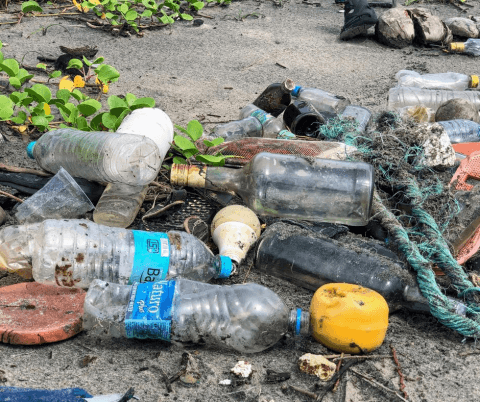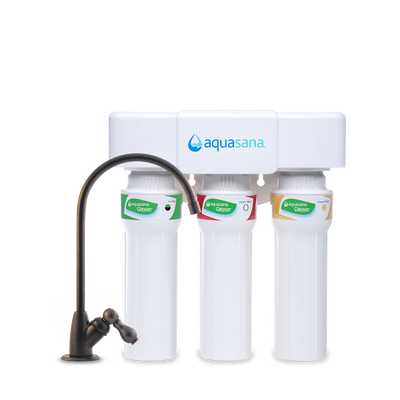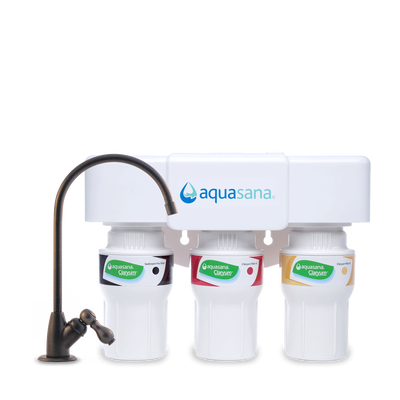When the Global Climate Strike happened, the core takeaway message was clear: band together now and slow the pace of climate change.
Whether it’s drought, mudslides, wildfires, or hurricanes, the cause is the same — climate change and its effect on access to clean drinking water is a growing concern worth remedying.
When it comes to water pollution in particular — whether it’s microplastics, contaminants, or more — we’re rapidly faced with one question: how much of it is caused by human activity, and what can we do about it?
Understanding Water Pollution
From the comfort of our own homes, it might seem as if water pollution isn’t too terrible. Simply turn on the kitchen faucet, and let the water flow, right? However, water pollution is everywhere, industrialized nations or not, and can take many different forms.
As defined by the National Resources Defense Council (NRDC), “Water pollution occurs when harmful substances—often chemicals or microorganisms—contaminate a stream, river, lake, ocean, aquifer, or [another] body of water, degrading water quality and rendering it toxic to humans or the environment.”
Since water is known as a “universal solvent” it is particularly vulnerable to contaminants and pollutants, as it acts as a sponge for toxins.
As the NRDC writes, there are many different kinds of water pollution, including:
- Groundwater
- Surface water
- Ocean water
- Point source (when pollution comes from a single source, like an oil rig)
- Nonpoint source (the leading cause of water pollution, this is when pollution comes from multiple sources, like agricultural runoff)
- Transboundary (when polluted water spills from one country to another)
So How Much is Man-Made?
Well, as with anything that’s science-adjacent, that’s a long question to answer. The short answer? Almost all of it.
And while opting for paper over plastic straws at your local coffee shop will help the turtles, climate change isn’t about making individual changes in your daily life. Climate change, particularly as it relates to man-made water pollution exists on a much larger, industrial-sized scale.
More specifically, there are a few key industries contributing to water contamination around the world. Let’s take a look.
Agriculture
As we’ve previously discussed, the Agricultural industry takes up nearly half of the Earth’s farmable land, and uses 70 percent of the Earth’s drinking water. “According to a recent report from the Environmental Protection Agency (EPA), “world pesticide usage at the producer level totaled nearly 6 billion pounds annually in both 2011 and 2012… Between 2008 and 2012, herbicides accounted for the largest portion of global usage (approximately 50% annually in all years), followed by fumigants, insecticides, and fungicides, respectively. U.S. pesticide usage totaled over 1.1 billion pounds annually in both 2011 and 2012, with herbicides accounting for nearly 50% of total U.S. pesticide usage in 2011 and nearly 60% of usage in 2012.”
from the Environmental Protection Agency (EPA), “world pesticide usage at the producer level totaled nearly 6 billion pounds annually in both 2011 and 2012… Between 2008 and 2012, herbicides accounted for the largest portion of global usage (approximately 50% annually in all years), followed by fumigants, insecticides, and fungicides, respectively. U.S. pesticide usage totaled over 1.1 billion pounds annually in both 2011 and 2012, with herbicides accounting for nearly 50% of total U.S. pesticide usage in 2011 and nearly 60% of usage in 2012.”
Think about it. Every time it rains, all of those pesticides and herbicides are being washed into the groundwater, funneling into nearby rivers, streams and lakes — the exact place many municipalities get their drinking water from.
Wastewater
To the average American, it’s just a natural part of our every day: whether it’s washing our dishes, taking a post-workout shower, or brushing our teeth. It all goes down the drain. Out of sight, out of mind.
But according to the NRDC, “more than 80 percent of the world’s wastewater flows back into the environment without being treated or reused, according to the United Nations; in some least-developed countries, the figure tops 95 percent. In the United States, wastewater treatment facilities process about 34 billion gallons of wastewater per day.”
Think that’s high? Well, it’s only as proportional as the water usage of each country, even in the U.S. As we’ve previously discussed, Americans use 300 gallons of water per day on average, per household. That’s nothing to sneeze at.
Microplastics & Manufacturing
 When anyone mentions the word “microplastics”, an image of a turtle or dolphin swimming in a sea of garbage is immediately conjured, bits of plastic wrapped in its flippers.
When anyone mentions the word “microplastics”, an image of a turtle or dolphin swimming in a sea of garbage is immediately conjured, bits of plastic wrapped in its flippers.
You can see instances of this across the globe. But more specifically, in an area surrounding the Great Pacific Garbage Patch (GPGP). The GPGP is an island-like formation that sits in the Pacific Ocean on top of the water, entirely made up of plastic bits, and has been described as “larger than Texas”. Some of it is an amalgamation of plastic bottles and bits, but for the most part, it’s actually plastic from the fishing industry itself. According to National Geographic, “of the 79,000 metric tons of plastic in the patch, most of it is abandoned fishing gear—not plastic bottles or packaging”.
If Finding Nemo were written about our actual planet, Nemo might never have been found.
What Can We Do to Prevent Water Pollution?
Preventing water pollution is no easy feat. On the individual level, it might feel that what you’re doing is just a drop in a very large bucket. But aside from calling your representatives, changing your purchasing habits to only support companies that promote eco-friendly products, and trying to orchestrate change on a larger scale, here are the changes you can make on a smaller scale from your own home.
- Keep a fat jar under the sink to collect all your oils and fats from cooking, and then discard with your solid waste when done to avoid putting them back into the environment (and into your water).
- Keep solids, well, solid. When you use a garbage disposal, those pesticides and herbicides, pharmaceuticals and more from your foods end up in your water supply. By leaving them solid and putting them in a composting bin, you’re doing your part in preventing contaminants from entering your water supply.
- Update all of your home appliances to the latest versions and make sure they are labeled with the “Energy Star” logo. According to the Environmental and Energy Study Institute (EESI), “Appliances and building-related equipment such as electric motors, lighting, refrigerators, and water heaters account for almost all the energy used in buildings. [The Department of Energy] estimates that these products represent about 90 percent of residential energy use, 60 percent of commercial building energy use, and 30 percent of industrial energy use. And buildings are massive energy users: there are roughly 115 million households and 5.6 million commercial buildings in the United States, representing more than 40 percent of total energy consumption and 70 percent of electricity usage—more than for transportation and industry.” When Americans switched to Energy Star products, these products prevented more than 300 million metric tons of greenhouse gas emissions,
- Regularly check your appliances for leaks. As we’ve previously discussed, 24 percent of average daily water usage is from the toilet, 20 percent is from the shower, 19 percent is from the faucet, 17 percent is from the washing machine, 8 percent is for “other”. But a massive 12 percent of average daily water usage is from water leakage. Continually check your appliances for cracks and leaks, and make sure everything is running as desired.
- Don’t dispose your pharmaceuticals in the toilet. A recent study found that more than 50 water treatment facilities tested positive for at least 25 drugs. The Federal Drug Administration (FDA) is encouraging all Americans taking medication to dispose of their pharmaceuticals by making use of their take-back program in an effort to curb the disposal of meds down the toilet.
- Invest in a water filter. Some of the most energy-efficient appliances come in the form of water filtration. To adequately rid your water supply of contaminants like herbicides and pesticides, and to ensure that you’re drinking clean, healthy water, a water filter like the Aquasana 3-Stage Max Flow is the way to go. This 800-gallon capacity Under Sink filter uses NSF Certified Claryum® filtration technology independently tested and proven to remove over 97% of chlorine and chloramines. It also reduces heavy metals like lead and mercury, chlorine-resistant cysts like giardia and cryptosporidium, organic chemicals like herbicides, pesticides and VOCs, pharmaceuticals and more. Plus, it’s eco-friendly, designed to reduce plastic waste by minimizing disposable plastic parts.
a massive 12 percent of average daily water usage is from water leakage.
Water contamination is already a huge problem that many are facing as the effects of climate change begin to take their toll, and it’s all the more true for those living in more rural or economically-devastated regions of the world. But we can help. Don’t let contaminants win, because, at the end of the day, you have to be the change you want to see in the world.

